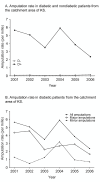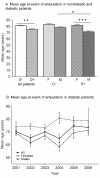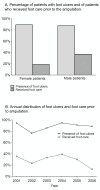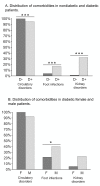A retrospective analysis of amputation rates in diabetic patients: can lower extremity amputations be further prevented?
- PMID: 22385577
- PMCID: PMC3362773
- DOI: 10.1186/1475-2840-11-18
A retrospective analysis of amputation rates in diabetic patients: can lower extremity amputations be further prevented?
Abstract
Background: Lower extremity amputations are costly and debilitating complications in patients with diabetes mellitus (DM). Our aim was to investigate changes in the amputation rate in patients with DM at the Karolinska University Hospital in Solna (KS) following the introduction of consensus guidelines for treatment and prevention of diabetic foot complications, and to identify risk groups of lower extremity amputations that should be targeted for preventive treatment.
Methods: 150 diabetic and 191 nondiabetic patients were amputated at KS between 2000 and 2006; of these 102 diabetic and 99 nondiabetic patients belonged to the catchment area of KS. 21 diabetic patients who belonged to KS catchment area were amputated at Danderyd University Hospital. All patients' case reports were searched for diagnoses of diabetes, vascular disorders, kidney disorders, and ulcer infections of the foot.
Results: There was a 60% reduction in the rate of amputations performed above the ankle in patients with DM during the study period. Patients with DM who underwent amputations were more commonly affected by foot infections and kidney disorders compared to the nondiabetic control group. Women with DM were 10 years older than the men when amputated, whereas men with DM underwent more multiple amputations and had more foot infections compared to the women. 88% of all diabetes-related amputations were preceded by foot ulcers. Only 30% of the patients had been referred to the multidisciplinary foot team prior to the decision of amputation.
Conclusions: These findings indicate a reduced rate of major amputations in diabetic patients, which suggests an implementation of the consensus guidelines of foot care. We also propose further reduced amputation rates if patients with an increased risk of future amputation (i.e. male sex, kidney disease) are identified and offered preventive treatment early.
Figures





References
-
- Larsson J, Agardh CD, Apelqvist J, Stenström A. Long-term prognosis after healed amputation in patients with diabetes. Clin Orthop Relat Res. 1998;350:149–158. - PubMed
Publication types
MeSH terms
LinkOut - more resources
Full Text Sources
Medical

